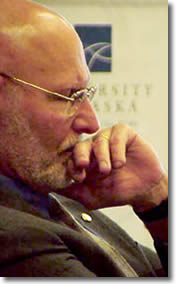University of Alaska, Big Oil An Awkward Mix
December 19th, 2006
By Susan B. Andrews and John Creed
Kotzebue, Alaska - Without credibility, a university has nothing. Unfortunately, the very person who should be upholding the University of Alaska's integrity we must assign a failing grade.
From his comfortable campus perch in Fairbanks, UA statewide President Mark Hamilton for too long has been running Big Oil up the university's flagpole.

First, some background: In 1999 when BP and ARCO sought a merger, many Alaskans distrusted the consolidation of so much political and economic clout on the North Slope. Many worried-rightly-the merger would aggravate environmental problems. Nevertheless, the proposed merger did offer the state some bargaining power: The oil companies could merge, but with stipulations.
The deal, which included waste clean-up and corrosion monitoring provisions, also required BP and ARCO (now ConocoPhillips) to make periodic payments to the University of Alaska. Though the agreement dubs UA "a charitable entity," these required payments are not "charitable" donations but rather indirect oil royalty payments negotiated during the merger. Within the context of Big Oil's massive Alaska profits, this arrangement is more than fair.
The American Heritage Dictionary defines "gift" as something of value "bestowed voluntarily without compensation." Nevertheless, with great fanfare the flamboyant Hamilton has regularly showcased the oil company payments as if they were discretionary, good-citizenship gifts from the oil patch.
UA's well-oiled PR machine also has lured the press into portraying these annual payments as "gifts" despite the merger agreement.
"Hamilton lauded the companies and welcomed the open-ended gift," wrote News-Miner reporter Stefan Milkowski after a staged media event "announcing" the oil company "gift," or "donation," two words Milkowski used no less than 12 times in his brief story, despite also noting the money was derived from an "obligation" of the oil-company merger.
Apparently it's not enough that BP has a basketball tournament at the University of Alaska Fairbanks named after the company. In November 2005 in front of basketball fans, BP officials "produced two UAF jerseys bearing the number 2.28 to represent their gift of $2.28 million," the News-Miner reported. A question for Mr. Hamilton: Can UA get much more tacky?
As UA professors, we are uncomfortable watching our university president shill for oil companies.
On Aug. 6, banner headlines in three major newspapers statewide in a UA Foundation advertisement shouted: " University of Alaska providing the edge, with thanks to BP and ConocoPhillips." Hamilton also lavished praise on his corporate consorts for "the $23 million donated by BP and ConocoPhillips over the last six years ."
That same three-quarter-page ad also featured Dr. T. Berry Brazelton, the internationally renowned child development specialist who spoke at UA's Fairbanks campus in July. Brazelton appears alongside full-color BP and ConocoPhillips logos.
We asked UA spokeswoman Kate Ripley about Hamilton and Dr. Brazelton being featured in those ads.
Even after Alaska's soaring heating fuel and gas prices and BP's irresponsible North Slope pipeline corrosion crisis last summer, Ripley defended Hamilton 's cozy relationship with Big Oil. Hamilton , she said, is touting the UA programs the money supports, not the companies themselves. "He's been very outspoken in his public appreciation of those donations," Ripley said.
So if Hamilton can't keep his distance from an embattled industry, did UA at least get Brazelton's permission to use his image specifically in that ad?
"The university, through Summer Sessions, had permission to use Dr. Brazelton's photo and bio information for publicity purposes, which includes university advertising," replied Ripley.
Not exactly, says Brazelton's office at Harvard.
"Dr. Brazelton ... was not aware of the source of the funding prior to arriving in Fairbanks for the event, nor was he aware of the advertisement," explained Suzanne Otcasek, Brazelton's assistant.
To his recollection, Brazelton has never "associated himself professionally with the oil industry ... and hasn't endorsed their products or policies." Brazelton's life's work, Otcasek said, "has been supporting families of young children."
The day after the ad using Brazelton appeared, BP made international headlines after it announced a Prudhoe Bay shutdown. The press reported oil spills on the tundra from "dangerous corrosion of North Slope pipelines."
"That timing was very unfortunate," admitted Ripley.
Indeed.
Pandering does carry risks. Sadly, Hamilton 's hustling for the oil patch is neither necessary nor honest. These payments are not outright gifts to the university. They are installments in a negotiated payment schedule for which the state has granted the oil companies valuable consideration. Hamilton knows that.
Our university president should not be pimping for Big Oil. We Alaskans do not employ him as an industry publicist, but as a guardian of a university's integrity.
Susan Andrews and John Creed are humanities professors at Chukchi College, the Kotzebue-based UA branch in Northwest Arctic Alaska.
